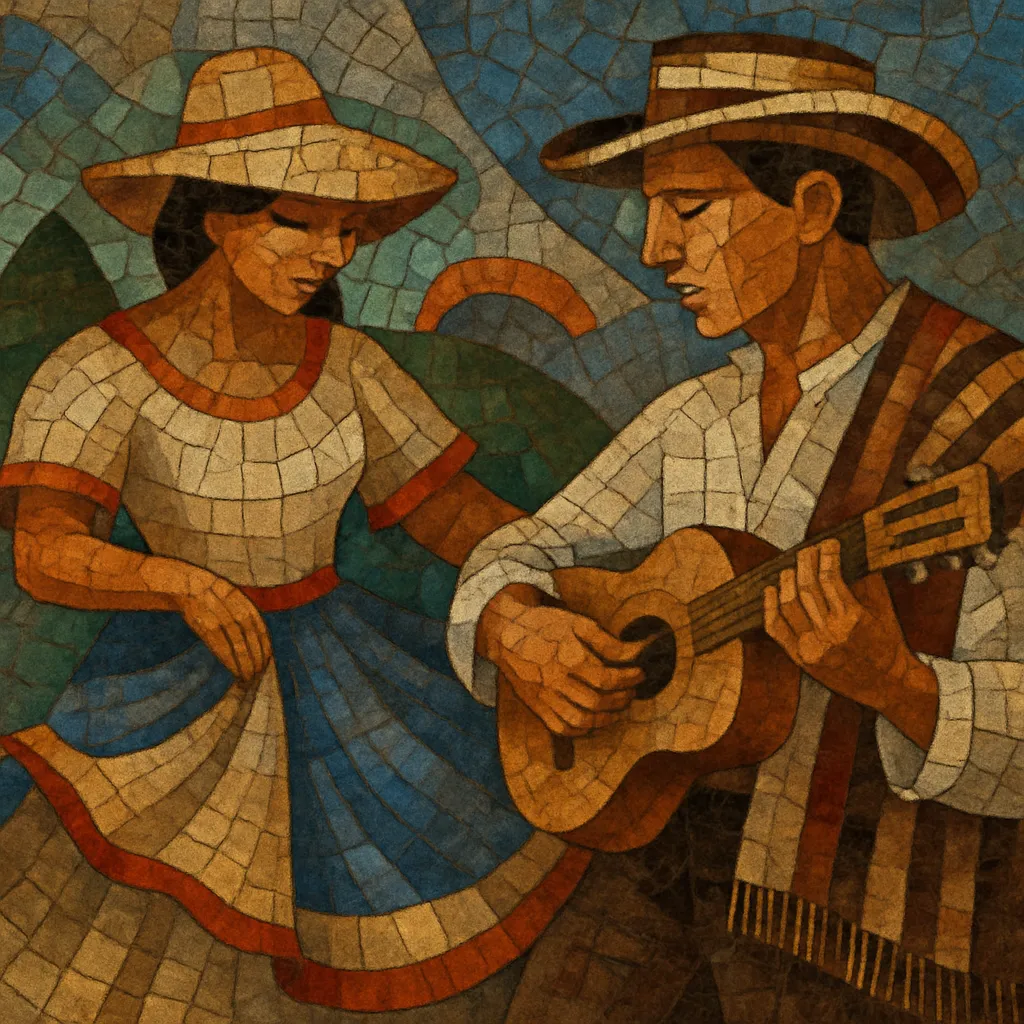Bambuco is a traditional Andean song-dance from Colombia characterized by a lilting 6/8 meter and the frequent use of sesquiáltera (the interplay between 6/8 and 3/4 feels). It is commonly performed by small string ensembles—most notably tiple, bandola, and guitar—and can be sung or purely instrumental.
Stylistically, bambuco blends Iberian melodic-harmonic language with indigenous Andean phrasing and African-derived rhythmic sensibilities. The result is a bittersweet, lyrical character with gentle syncopations, expressive melodies, and elegant, courtly dance gestures. Its repertoire ranges from intimate serenade-like pieces to more festive regional variants, and it remains a pillar of Colombia’s Andean musical identity.
Bambuco emerged in the 19th century in Colombia’s Andean interior (departments such as Huila, Tolima, Cundinamarca, Boyacá, Santander, and Antioquia). It took shape as a salon and folk dance-song, blending Iberian melodic-harmonic practice with indigenous Andean phrasing and African-descended rhythmic sensibilities. The hallmark sesquiáltera—shifting accents between 6/8 and 3/4—mirrors broader Hispanic-American rhythmic practices that date back to the colonial period.
By the late 1800s and early 1900s, bambuco had moved fluidly between rural festivities and urban salons. Print culture, early recordings, and the rise of professional ensembles standardized instrumentation around the Colombian tiple, bandola, and guitar. Composers and arrangers began to codify melodic turns, cadences, and accompaniment patterns, helping unify a diverse set of regional expressions under the shared label of “bambuco.”
In the mid-20th century, radio, labels, and national festivals elevated bambuco as a symbol of Colombian Andean identity. Vocal duos and tiplistas popularized a canon of beloved songs, while composers contributed new classics that balanced tradition with refined, salon-influenced harmony. The genre became central to concert programs, competitions, and national celebrations.
Today, bambuco thrives in festivals like the Festival Mono Núñez and in conservatory settings where the tiple, bandola, and guitar repertoire is taught and expanded. While remaining a living tradition in the Andean region, bambuco also appears in crossover works, orchestral arrangements, and singer-songwriter contexts, ensuring its continuity within Colombia’s broader musical life.
Use a small Andean string ensemble centered on tiple (12-string Colombian guitar), bandola (lute-like melody instrument), and guitar (harmonic foundation). Requinto, flute, or light percussion can appear, but strings carry the style’s core timbre.
Write in 6/8 while embracing sesquiáltera: alternate or superimpose 6/8 and 3/4 feels to create gentle metric tension. Accents often suggest two dotted-quarter pulses per bar (6/8) while melodic or accompaniment figures imply three quarter-note pulses (3/4). A moderate tempo (around dotted-quarter = 72–96) preserves the dance’s graceful lilt.
Favor diatonic harmony in major or minor with clear functional movement (I–IV–V–I), tasteful secondary dominants, and occasional modal color from Andean practice. Common forms include strophic verses with refrains or A–B binary designs. Cadences are often classical in character (perfect authentic or plagal), and introductions/interludes highlight bandola or tiple.
Compose lyrical, singable melodies with expressive appoggiaturas and ornamental turns. Countermelodies on bandola or tiple enrich the texture. Balance homophonic song backing (guitar/tiple) with brief melodic breaks.
Texts typically evoke regional landscapes, love, nostalgia, and everyday life. Keep imagery concise and poetic, matching the dignified yet intimate mood of the dance. Vocal delivery is warm and unforced, allowing the metric sway to remain clear.


